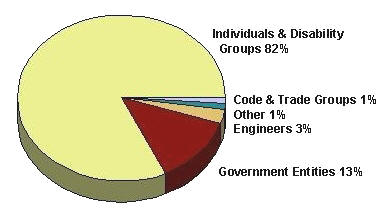Board Receives Over
1400 Comments on Rights-of-Way Guidelines (12/18/02)
Last June, the Board released
draft guidelines on accessible public rights-of-way and made
them available for public comment. The guidelines address access to public
streets and sidewalks for persons with disabilities, including crosswalks, curb
ramps, street furnishings, parking, and other components of public
rights-of-way. In response to the draft, the Board received more than 1400
comments from interested
persons and organizations, including disability groups, civil engineers,
transportation specialists, public works departments, and others. Comments were
submitted by e-mail, mail, fax, and in testimony during an information
meeting the Board held in Portland, Oregon.
The deadline for comments was October 28, 2002.
 The
vast majority of comments (82%) came from individuals and organizations
representing people with disabilities. Most of these comments addressed
provisions in the guidelines concerning access for people with vision
impairments at street crossings. The draft guidelines included new
specifications for detectable warnings, a distinctive surface pattern of domes
that are intended to provide a tactile warning of entry into streets where curb
faces are absent, such as at curb ramps and blended transitions. The guidelines
also included requirements for audible and tactile indicators where walk signals
are provided at intersections. People with vision impairments and organizations
representing them were strongly divided on these provisions. Many opposed
audible pedestrian signals and, to a lesser extent, detectable warnings as
unnecessary and costly burdens. Some argued that proper training and the
availability of other cues, such as the sound of passing vehicle traffic,
obviate the need for such requirements. On the other hand, many others strongly
endorsed the draft requirements as essential for equal access and safety at
street crossings for people with vision impairments. Tactile warnings and
audible signals, they argued, provide the same degree of information afforded
sighted pedestrians.
The
vast majority of comments (82%) came from individuals and organizations
representing people with disabilities. Most of these comments addressed
provisions in the guidelines concerning access for people with vision
impairments at street crossings. The draft guidelines included new
specifications for detectable warnings, a distinctive surface pattern of domes
that are intended to provide a tactile warning of entry into streets where curb
faces are absent, such as at curb ramps and blended transitions. The guidelines
also included requirements for audible and tactile indicators where walk signals
are provided at intersections. People with vision impairments and organizations
representing them were strongly divided on these provisions. Many opposed
audible pedestrian signals and, to a lesser extent, detectable warnings as
unnecessary and costly burdens. Some argued that proper training and the
availability of other cues, such as the sound of passing vehicle traffic,
obviate the need for such requirements. On the other hand, many others strongly
endorsed the draft requirements as essential for equal access and safety at
street crossings for people with vision impairments. Tactile warnings and
audible signals, they argued, provide the same degree of information afforded
sighted pedestrians.
Civil engineers, public works departments, state highway divisions and
transportation departments, and leading industry organizations, such as the
American Association of State Highway and Transportation Officials (AASHTO),
also provided detailed input on the guidelines. Concerns and recommendations
addressed provisions for traffic roundabouts, criteria for crosswalks,
construction tolerances, the cost impact of various requirements, the
application of requirements in alterations and public improvement projects, and
differences between defined terms and industry terminology.
The Board will revise the guidelines based on its review of the feedback it has
received and will provide another opportunity for public comment. Once
finalized, the document will be incorporated into the Board’s Americans with
Disabilities Act Accessibility Guidelines (ADAAG), which cover access to a wide
range of facilities in the public and private sectors. It will also be made part
of guidelines the Board maintains under the Architectural Barriers Act (ABA),
which requires access to certain federally funded facilities.